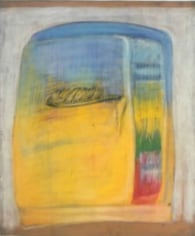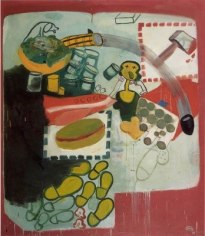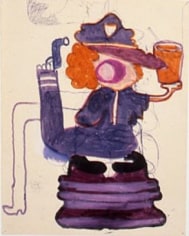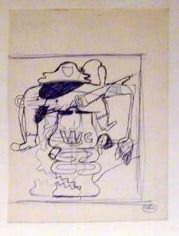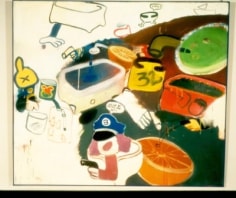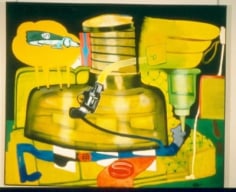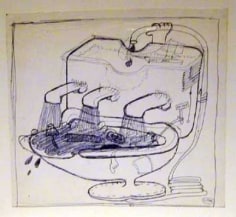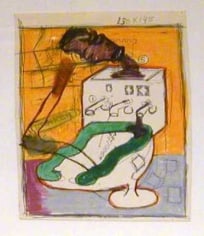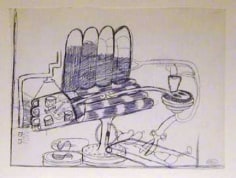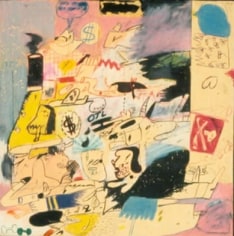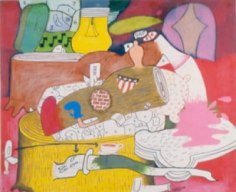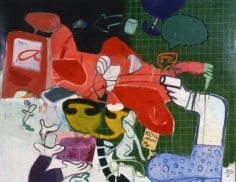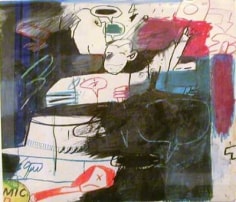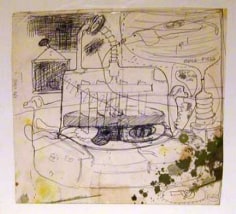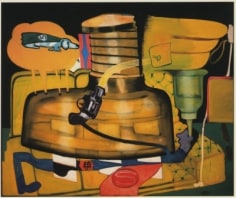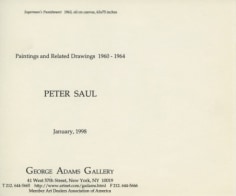Peter Saul
| Early Paintings and Related Drawings, 1960-1964 |
|
| Jan 1 - Jan 30, 1998 | |
In 1956, Peter Saul graduated from Washington University in St. Louis and moved with his first wife to Europe. After a brief stay in London, they lived in Amsterdam (1956-1958), near Paris (1958-1962), and finally in Rome (1962 -1964) before returning to the US and settling in Mill Valley, California. It was during this period that Saul defined himself as an artist. At the outset a self-described expressionist painter of landscapes and interiors, Saul soon developed the major themes that remain central to his work even today. The present exhibition consists of paintings and drawings made during his years in Europe which reflect Saul's artistic development as a social critic as well as his involvement with Pop Art, a movement with which he was identified during this time. Saul was fascinated from an early age by movies and the comics, and even after art school their influence persisted. According to Saul, "The years 1959 - 1961 were pretty much used in reconciling specific drawings from Mad [Magazine] with my need to resemble deKooning." The influence of popular culture - especially the comics - is evident not only in Saul's style and use of cartoon characters - Superman, Mickey Mouse and Donald Duck appear as early as 1960 - but also of dialogue balloons, and multi-panel compositions. Along with a cast of characters out of Disney, greed, sex and violence - tabloid subjects that continue to remain central to Saul's work - make their first appearances during this period. Saul was not interested in simply making cartoon painting, however: "The problem with cartooniness is that it smooths out too many bumps... To get those 'bumps' back is a lot of work... I summon my memory of drawings on lavatory walls. That usually does it." These early paintings and drawings employ an over-all composition and mark-making typically associated with abstract-expressionism and, at the same time, a visual vocabulary composed entirely of images from popular culture. For all their references to popular culture, Saul was not in fact a "Pop" artist. While he was initially considered a member of the movement and was even included in several Pop surveys (Lucy Lippard's Pop Art of 1966, for example), he was soon dropped and only recently reinstated through his inclusion in the LA County/Whitney Museum's recent "Hand Painted Pop." The most important distinction between Saul and the artists usually identified with Pop Art is that Saul was interested in the psychological. And, while his early works share similarities with artists such as Lichtenstein, Rivers or Rosenquist, it is artists such as deKooning, Beckmann and Francis Bacon who should be looked to as more important sources. Paintings such as IceBox #3 or Valda Sherman, for example, are rooted less in the Pop Art of Rivers than in social commentary of Bacon and Beckmann. According to Saul, as far as Pop Art was concerned, "my painting had too much emotion." Exhibition Checklist Clockwise from left: 1. Study for 'Ice Box', 1957, pastel on paper, 22 x 18 1/2 inches 2. Icebox #3, 1961 oil on canvas, 69 x 58 1/2 inches Saul began incorporating images taken from advertisements in his work as early as 1956 when he was still in art school, several of which were exhibited in the "Missouri Show" held in St. Louis that same year. He made a series of at least nine "Ice Box" paintings between 1959 and 1964, and this study, made in Holland at end the of 1957, is the first image he ever made of this subject. Saul searched through copies of Life Magazine for a suitable model and, not finding what he needed, made the drawing from his imagination. 3. Study for 'Valda Sherman', 1961 pastel, marker, ink on paper, 8 x 6 inches 4. Study for 'Valda Sherman' (WC), 1961 ink on paper, 8 1/2 x 6 3/4 inches 5. Valda Sherman, 1961 oil on canvas, 51 x 59 inches Valda Sherman was a cartoon character of a police woman that appeared in a deodorant advertisement on the back page of comic books during the 1940s. 6. Study for 'Superman's Punishment', 1963 ink, oil on paper, 9 3/4 x 10 1/2 inches 7. Superman's Punishment, 1963 oil on canvas, 62 x 74 inches Superman and Superdog were among Saul's favorite subjects, and he depicted them frequently battling crooks, in jail, even in the electric chair. "Superman's Punishment" was painted while Saul was living in Rome. He had acquired an expensive and very elaborate hardboiled egg slicer which served as the model for this painting's instrument of torture. 8. Study for 'Superman vs Toilet Duck', 1963 ink on paper, 6 3/4 x 9 1/4 inches 9. Untitled Study (Kutty Sark), 1963 ink on paper, 10 x 11 1/8 inches 10. Untitled Study (Toilet), 1963 pastel, marker, ink on paper, 6 1/4 x 5 1/4 inches Saul's use of the toilet image was inspired by the English artist John Bratby. His painting of a toilet won an international prize in 1957 and created a huge scandal. Saul, greatly impressed, decided to incorporate the image in his own work and it appears frequently in his work of this period. 11. Untitled Study (Barbara Rose), 1963 ink on paper, 8 1/2 x 11 1/2 inches Barabara Rose had already written negative reviews of his New York exhibitions, and so she became the subject of what is the first in a series of "critic" paintings, the most recent being "Art Critic's Suicide" of 1996 which depicted Peter Schjeldahl and Hilton Kramer. 12. Pimples, 1960 crayon and collage on paper, 21 1/2 x 21 1/4 inches This drawing relates to a painting titled "Sex Boat" of the same year which features a swooning, pimple-faced girl along with a sign that says "Bad Skin". According to Saul, the image "could refer to that great slogan ' What would you do if you saw a Japanese soldier raping your sister' and if she had pimples and swooned at the idea..." This drawing is a good example of the influence of deKooning, especially in it's compositional structure. 13. Mad Pilot, 1961 oil on canvas, 73 3/4 x 59 3/8 inches 14. Superman, 1962 pastel, ink on paper, 26 x 29 3/4 inches 15. Untitled (Log/Ham), 1964 pastel, ink on paper, 28 x 33 3/4 inches 16. Comic Strip, 1961 crayon on paper, 17 x 50 1/2 inches "Comic Strip" is one of a few direct references to comics in Saul's work. As the title suggests, the drawing mimics a comic strip down to the multi-panel format and uses cartoon balloons. That this is not a direct borrowing from a comic, as in a Lichtenstein, for example, is clear not only by the use of collage and the spacial ambiguity of the composition, but also by the unintelligible balloons that prevent a coherent "reading" of a narrative. 17. MIC, 1961 pastel, ink, collage on paper, 14 1/4 x 16 1/2 inches By 1964 Saul had begun to shift away from the deKooning-influenced compositions as he was becoming less interested in working in the Abstract-Expressionist style. Saul was also increasingly interested in making paintings more specifically about issues, and the imagery in the work of this time is more distinct and less random than in previous years. By 1965-1966, when he was living and working in Mill Valley, Saul would abandon abstract-expressionist tendencies altogether, making hard-edged, intensely colored protest paintings that would occupy him for the remainder of the decade. |


